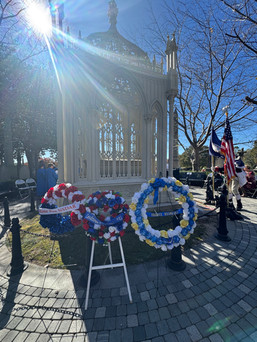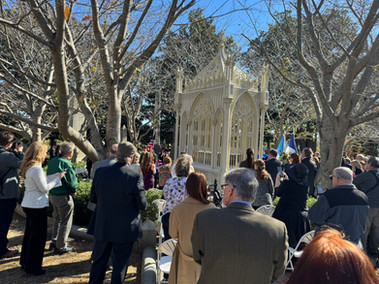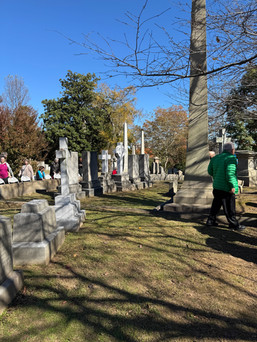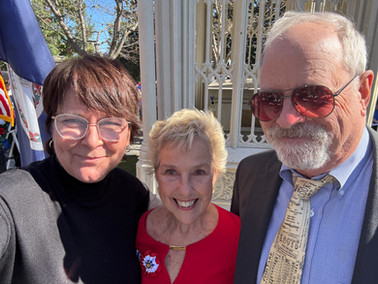Bringing Eliza Home: The Reburial of Eliza Monroe Hay at Hollywood Cemetery
- Deborah Newman

- Oct 25
- 3 min read
On October 23, 2025, a woman once dismissed by history as aloof and forgettable finally received the dignity she deserved. Eliza Monroe Hay—the daughter of President James Monroe—was reinterred at Hollywood Cemetery in Richmond, laid to rest among her family nearly two centuries after she died in Paris in 1840. Her journey home was the result of years of meticulous research, fundraising, and diplomacy, and it restores Eliza to the place her life story truly belongs: beside her parents and sister, overlooking the James River.
From an Unmarked Grave in Paris to the Monroe Family Plot
Eliza died in Paris in 1840 and was buried in an unmarked grave at Père Lachaise. Her life, overshadowed by illness, widowhood, and financial hardship after her father’s death, trailed off in obscurity. That changed when Barbara VornDick, a retired Virginia teacher and researcher, uncovered letters and documents that corrected long-standing myths about Eliza and revealed the difficult realities she faced at the end of her life. Those discoveries sparked the Bringing Eliza Home project—an ambitious effort to locate, exhume, and repatriate Eliza’s remains to Virginia.
In May 2025, Eliza’s remains arrived back in the United States. On October 23, the Diocese of Richmond presided over her reinterment at the top of Hollywood Cemetery, where she was placed between her mother and sister, and near her father’s tomb—a quiet, moving reunion that drew hundreds of attendees.
A Ceremony of Memory and Restoration
Among those present was Deborah Newman, owner of Petite Taway, who attended both as a supporter of the project and in her capacity as Vice President of the Colonial Beach Historical Society and Museum and Board Member of the Westmoreland County Museum.
Newman reflected afterward that “bringing Eliza home felt like bringing a piece of Westmoreland County’s own history full circle.” As someone deeply involved in preserving and promoting Virginia’s cultural heritage, she described the ceremony as “a moment of reverence for every woman whose story has been lost or misunderstood.”
The service combined historical remembrance with spiritual reflection. Clergy from the Cathedral of the Sacred Heart offered prayers; a choir sang; and a color guard participated—ceremonies that honored both Eliza’s Catholic faith and her historical role as a First Daughter. Attendees included state and local leaders, historians, and community members who had supported the years-long effort.
Why Eliza Matters
Eliza Monroe Hay stood at the crossroads of diplomacy, politics, and family life in the early republic. As her mother’s health declined during James Monroe’s presidency, Eliza often served as White House hostess, navigating Washington society at a time when women’s political influence was measured in subtle gestures and social diplomacy. Her European education—she studied under Madame Campan in France—shaped her worldview and manner, giving her a cosmopolitan perspective rare for women of her era.
Yet the final chapter of her life is what gives this reburial its deeper resonance. Recent research reveals a woman of perseverance and compassion, who endured loss and poverty with quiet dignity. Her reburial is not only a homecoming—it’s an act of historical restoration.
Community History at Its Best
The Bringing Eliza Home project illustrates how collaborative community history can be. The Historic Fredericksburg Foundation, Inc. (HFFI) coordinated outreach and fundraising; James Monroe sites across Virginia amplified the story; and the Diocese of Richmond guided the ceremony with grace.Local historians, preservationists, and civic leaders—including representatives from Westmoreland County—played a role in ensuring that this moment united scholarship, heritage, and reverence.
A Restored Legacy
Today, at Hollywood Cemetery, Eliza rests beside her mother and sister, near her father’s iconic tomb—finally reunited with the family whose legacy helped shape America. Her story reminds us that women’s histories are not footnotes, but vital threads in the nation’s fabric.For those who work to preserve Virginia’s history, including advocates like Deborah Newman, Eliza’s return home represents the enduring power of memory—and the importance of giving voice to those history almost forgot.






































































































